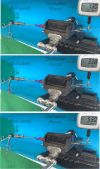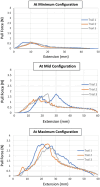Force-adjustable parallel-occlusion grasper
- PMID: 37995091
- PMCID: PMC10871571
- DOI: 10.1097/JS9.0000000000000911
Force-adjustable parallel-occlusion grasper
Abstract
Background: During laparoscopic surgery, the operating surgeon grasps sections of the gastrointestinal tract (GIT), including delicate structures, with long (270 mm) 5 mm diameter graspers. These grasping instruments increase the risk of iatrogenic damage due to crushing of the grasped tissue. This risk is increased significantly by diseases such as bacterial peritonitis and inflammatory bowel disease and reduced but not abolished by using parallel-closing laparoscopic instruments. This study describes the design and laboratory testing of fully developed and tested smart graspers capable of reducing the grasping force used for inflamed tissues and hollow viscera.
Materials and methods: In an ISO 13485-certified mechanical laboratory and CAD machine workshop, the authors have designed, developed, and evaluated a smart gasper capable of exerting a preselected uniform grasping force on the gastrointestinal tract and other structures/ tissues, through a mechanism incorporated in the handle of the instrument. This enables the control and graded reduction of the grasping force by the incorporation of a compression spring. The authors named the new instrument the force-adjustable parallel-occlusion grasper (FA-POG) because, in addition to applying a uniform force on the grasped bowel/tissue, it also enables the surgeon to select the force before grasping, depending on its physical condition, and pathological state.
Results: FA-POG differs from traditional pinch-occlusion grasper in two respects: it exerts a uniform force on the grasped tissue/bowel and enables the operating surgeon to select and apply a predetermined uniform grasping force, ranging from 1 to 5 N, depending on the pathological condition of the bowel/structure. The ISO 13485-certified and fully developed prototype has been subjected to various grasping in-vitro tests using freshly harvested porcine small-bowel segments obtained from a local abattoir, using Instron tensiometry.
Conclusions: The authors designed and α/β tested a parallel-occlusion gasper that enables the operating surgeon to select the force before grasping. This grasper design consists of end-effectors jaws with a 4-bar linkage mechanism for wide, uniform parallel-occlusion force, surpassing traditional scissor-type laparoscopic graspers. It incorporates a force-level controller knob, based on a spring-loaded mechanism, enabling surgeon-preselected grip force to prevent excessive grasping. The authors validated the design experimentally using porcine small-bowel segments, optimizing teeth for maximum grip friction to minimize slippage.
Copyright © 2023 The Author(s). Published by Wolters Kluwer Health, Inc.
Conflict of interest statement
There are no conflicts of interest.
Sponsorships or competing interests that may be relevant to content are disclosed at the end of this article.
Figures












References
-
- den Boer KT, Herder JL, Sjoerdsma W, et al. . Sensitivity of laparoscopic dissectors. What can you feel? Surg Endosc 1999;13:869–873. - PubMed
-
- Heijnsdijk EA, Pasdeloup A, van der Pijl AJ, et al. . The influence of force feedback and visual feedback in grasping tissue laparoscopically. Surg Endosc 2004;18:980–985. - PubMed
-
- Reyda CJ. Design of a pressure sensing laparoscopic grasper. Thesis (S.B.), Massachusetts Institute of Technology, Dept. of Mechanical Engineering, 2011. Accessed 13 December 2022. https://dspace.mit.edu/handle/1721.1/68854
-
- Berguer R. Surgical technology and the ergonomics of laparoscopic instruments. Surg Endosc 1998;12:458–462. - PubMed
-
- Berguer R, Gerber S, Kilpatrick G, et al. . An ergonomic comparison of in-line vs pistol- grip handle configuration in a laparoscopic grasper. Surg Endosc 1998;12:805–808. - PubMed
MeSH terms
LinkOut - more resources
Full Text Sources
Miscellaneous

